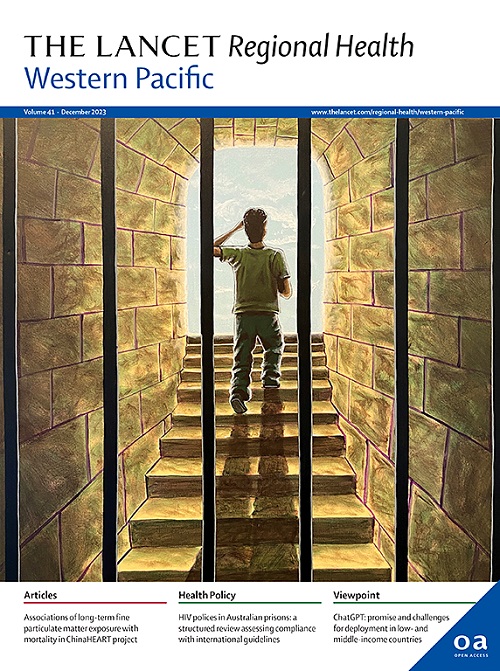Primary healthcare quality of migraine in China: a study using unannounced standardized patients
IF 7.6
1区 医学
Q1 HEALTH CARE SCIENCES & SERVICES
引用次数: 0
Abstract
Background
Migraine, a highly prevalent headache disorder, is associated with several adverse health outcomes if not properly managed, but little is known about the quality of primary healthcare for migraine. This study aims to assess the quality of primary healthcare for migraine in China using the unannounced standardized patient (USP) method.
Methods
This cross-sectional study, conducted as part of the Primary Health Care Quality Cohort in China (ACACIA) from April 2021 to January 2023, involved 196 unannounced visits for migraine across seven provinces. A two-step probability-proportional-to-size systematic sampling method was used to select institutions randomly. Ten qualified standardized patients (SPs) conducted the visits following standardized procedures. The quality of healthcare was assessed across five dimensions: effectiveness, safety, patient-centeredness, timeliness, and efficiency. The linear and logistic regression models were used to determine the factors influencing healthcare quality.
Findings
Our findings revealed that clinicians completed an average of 17.6% of the recommended questions and 4.9% of the recommended exams. The correct diagnosis and treatment rates were 31.1% and 62.2%, respectively. The average patient perception of patient-centeredness (PPPC) score was 2.5. The total time, including consultation and waiting time, averaged 14.5 min, with an average fee of 30.1 yuan. We found township health centers and hospitals outperformed clinics in completing recommended questions (β = 4.648, P = 0.024; β = 7.834, P < 0.001, respectively), recommended exams (β = 2.485, P = 0.040 for hospitals) and diagnosis quality (β = 1.396, P = 0.005 for hospitals). Hospitals also charged higher fees (β = 19.666, P = 0.018) and had longer waiting times (β = 8.176, P < 0.001) but shorter consultation times (β = −2.340, P = 0.020). Significant regional disparities were observed in western provinces, which are characterized by lower economic development and perform worse in terms of recommended questions, exams, and treatment despite incurring lower medical fees. While no significant differences in care quality between private and public institutions were found.
Interpretation
The quality of primary healthcare for migraine care in China is suboptimal, particularly in western regions and clinical settings. More actions are needed to enhance the quality of care and reduce regional and institutional disparities.
Funding
This work was supported by the National Science and Technology Major Project of China (2024ZD0523902) and the National Natural Science Foundation of China (Grant No. 72374149).
中国偏头痛的初级卫生保健质量:一项使用未通知的标准化患者的研究
背景:偏头痛是一种非常普遍的头痛疾病,如果管理不当,会导致几种不良的健康结果,但人们对偏头痛的初级保健质量知之甚少。本研究旨在采用未通知的标准化患者(USP)方法评估中国偏头痛的初级卫生保健质量。该横断面研究是中国初级卫生保健质量队列研究(ACACIA)的一部分,研究时间为2021年4月至2023年1月,涉及7个省份196例未通知的偏头痛患者。采用两步概率-比例-规模系统抽样法随机选择机构。10名合格的标准化患者(SPs)按照标准化程序进行了访问。医疗保健质量从五个方面进行评估:有效性、安全性、以患者为中心、及时性和效率。采用线性和逻辑回归模型确定影响医疗质量的因素。研究结果显示,临床医生平均完成了17.6%的推荐问题和4.9%的推荐检查。正确诊断率为31.1%,正确治疗率为62.2%。患者以患者为中心的感知(PPPC)平均得分为2.5分。包括咨询和等待时间在内的总时间平均为14.5分钟,平均费用为30.1元。我们发现乡镇卫生院和卫生院在完成推荐问题方面优于诊所(β = 4.648, P = 0.024;β = 7.834, P <;推荐检查(β = 2.485,医院P = 0.040)和诊断质量(β = 1.396,医院P = 0.005)。医院收费较高(β = 19.666, P = 0.018),候诊时间较长(β = 8.176, P <;0.001),但就诊时间较短(β = - 2.340, P = 0.020)。西部省份存在显著的地区差异,这些省份的特点是经济发展水平较低,尽管医疗费用较低,但在推荐的问题、考试和治疗方面表现较差。而私立和公立机构之间的护理质量没有显著差异。中国偏头痛的初级医疗保健质量不理想,特别是在西部地区和临床环境中。需要采取更多行动,提高护理质量,缩小区域和机构差距。基金资助:国家科技重大专项(2024ZD0523902)和国家自然科学基金(批准号:72374149)。
本文章由计算机程序翻译,如有差异,请以英文原文为准。
求助全文
约1分钟内获得全文
求助全文
来源期刊

The Lancet Regional Health: Western Pacific
Medicine-Pediatrics, Perinatology and Child Health
CiteScore
8.80
自引率
2.80%
发文量
305
审稿时长
11 weeks
期刊介绍:
The Lancet Regional Health – Western Pacific, a gold open access journal, is an integral part of The Lancet's global initiative advocating for healthcare quality and access worldwide. It aims to advance clinical practice and health policy in the Western Pacific region, contributing to enhanced health outcomes. The journal publishes high-quality original research shedding light on clinical practice and health policy in the region. It also includes reviews, commentaries, and opinion pieces covering diverse regional health topics, such as infectious diseases, non-communicable diseases, child and adolescent health, maternal and reproductive health, aging health, mental health, the health workforce and systems, and health policy.
 求助内容:
求助内容: 应助结果提醒方式:
应助结果提醒方式:


